
A small
boat on a big sea
By Mary Lois Detweiler
Miller ’50
I found my interests at Goshen College centered around
music and art; my husband Don Miller ’50 pursued courses in science at
Goshen and, by 1955, graduated from Jefferson Medical School. I taught sixth
grade and music in Telford, Pa.; Don then practiced medicine in Middlebury,
Goshen and Elkhart.
The two of us discovered not only a joy with
each other, but also, a shared curiosity about nature with a certain willingness
to seek adventure. We raised our four children, exposing them to camping, hiking
and sailing on Lake Michigan, and germinated this idea of sailing great distances.
I must admit my fervor for crossing a big ocean lagged behind that of Don’s
passion.
We set sail from Fort Lauderdale Jan. 5, 1987.
Our 37‘ sailboat, Horizon, embraced spare parts, staples, cans of veggies,
items for barter (fish hooks, paint brushes, bright cloth) and a closet that
held a very basic wardrobe. Ready to start the journey, we pushed through the
gates of the Panama Canal to find, revealed, geography we never knew existed,
and different cultures sharing common values. With the small space Don and I
shared, it soon became evident that collecting crafts and art from these cultures
would have to be limited. We do enjoy a small collection of canoes, outrigger
and dugouts that now travel across our living room wall. Small carvings, pottery
and weavings also remind us of this voyage that has so enriched our lives.
We have no way of knowing whether we are the
first Mennonites to sail around the world on a small boat, all alone; we’d
love to hear from others about sailing and particularly, information about Mennonites
and circumnavigation.
As Joseph Campbell expressed so well on a
PBS special the defining sum of our parts, “When you’re addressing
yourself to the horizon, to the world you’re in, then you’re in your
place in the world. It’s a different way to live.”
Life on a small
boat is simplicity . . .
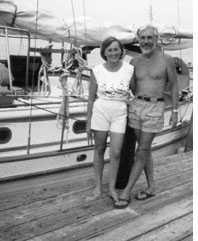 “And
I have felt a presence that disturbs me with joy whose dwelling is the light
of setting suns and the round ocean and the living air and the mind of man.”
“And
I have felt a presence that disturbs me with joy whose dwelling is the light
of setting suns and the round ocean and the living air and the mind of man.”
This paraphrase from Wordsworth’s Tintern
Abbey in some way encompasses my feelings about the journey I have shared
with my husband, Don.
As the enormous doors of the Panama Canal
close behind us and the vast blue of Pacific Ocean stretch ahead, doubts about
the circumnavigation ahead swirl through my thoughts.
The Horizon seems so small sailing
across the cobalt blue sea. After seven years honing our sailing skills along
the Eastern seaboard, we set out to see the world as few have opportunity to
do. Our sturdy boat, seaworthy and comfortable for the two of us, becomes home.
Thirty-seven days sailing across the Pacific becomes a test to all the knowledge
we have acquired about the effects of wind on the sails and the response of
waves to the boat. The few glitches encountered as we continue west are surpassed
by the exhilaration at the sight of those peaks of Fatu Hiva and the accomplishment
of our first ocean crossing. Perhaps it’s the first ocean crossing that
makes a landfall special, or perhaps it’s truly the connection we share
with these Polynesian folk. The French Polynesian Islands become the opening
chapter for Don and I as pages are added to our log detailing the discovery
of new cultures as we rejoice in shared values.
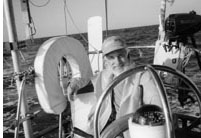 Studying
the nautical charts provides valuable information for safe passage. We discover
oceans are dotted with small islands and atolls that act as stepping stones
for us to hopscotch our way to new discoveries. We meet Doug and Jill Minter
in Western Samoa, here on their Peace Corp assignment, teaching agriculture
and nutrition. Doug’s dad, “Dr. Don,” was on the staff with my
Dr. Don at Goshen General. We leave this home of huge men displaying tattoos
as clothing and sail south to Tonga towards higher latitudes.
Studying
the nautical charts provides valuable information for safe passage. We discover
oceans are dotted with small islands and atolls that act as stepping stones
for us to hopscotch our way to new discoveries. We meet Doug and Jill Minter
in Western Samoa, here on their Peace Corp assignment, teaching agriculture
and nutrition. Doug’s dad, “Dr. Don,” was on the staff with my
Dr. Don at Goshen General. We leave this home of huge men displaying tattoos
as clothing and sail south to Tonga towards higher latitudes.
It’s midnight, the twinkling lights decorating
the homes of New Zealand reveal our first Christmas as we make our way to the
anchorage. I have a touch of homesickness – family seems so far away tonight.
We purchase a used car to cruise the highways of this country near the South
Pole. For six months we revel in the pastoral beauty of the North Island and
the snow covered peaks of the South Island.
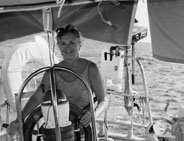 Regaining
our sea legs after such a vacation takes a few days as we sail the sea once
more. We have our sights on a unique spot in the middle of the South Pacific
Ocean. The chart’s only notation of this spot is a hazard to navigation.
At daybreak we see breaking waves along a reef. There is no land visible. An
undersea mount has risen until it just scratches the surface of the ocean to
create Minerva Reef. At high tide there is no evidence of its presence –
cause of countless shipwrecks. Here at this fragile refuge, we anchor in the
center of the circular reef. For three weeks we snorkel and dive with the six
sailboats that have found this special spot – here where the horizon spins
a continuous line for 360 degrees.
Regaining
our sea legs after such a vacation takes a few days as we sail the sea once
more. We have our sights on a unique spot in the middle of the South Pacific
Ocean. The chart’s only notation of this spot is a hazard to navigation.
At daybreak we see breaking waves along a reef. There is no land visible. An
undersea mount has risen until it just scratches the surface of the ocean to
create Minerva Reef. At high tide there is no evidence of its presence –
cause of countless shipwrecks. Here at this fragile refuge, we anchor in the
center of the circular reef. For three weeks we snorkel and dive with the six
sailboats that have found this special spot – here where the horizon spins
a continuous line for 360 degrees.
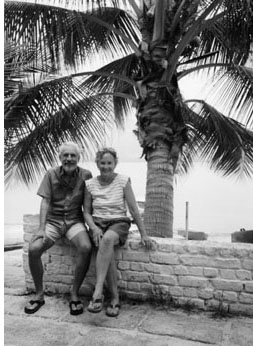 Winds
turning favorable, we sail on a “peace of a reef” towards the harbor
at Suva Fiji. New customs, new ceremonies, firewalkers and the sevu-sevu
ritual become a part of this country’s uniqueness. But still new cultures
await as we begin our second year of this journey with 10,000 having passed
under our hull. North across the equator we discover a 2,400 mile stretch of
islands along its border called Micronesia. This U.S. Trust Territory embraces
five countries, each with defining cultures. We are fascinated by the extraordinary
sailing skills of the ocean navigators of Pulawat, who are using the stars,
wave patterns, birds and clouds traveled great distances in their outrigger
canoes. To the tiny atoll, West Fayu, all alone, we chafe through our two anchor
lines at night and drift towards the reef. Awakened by the ominous thud we scramble
for our lives. We haul out the third anchor to winch ourselves from danger.
After four hours of sweat and strained muscles cranking the winch handle, we
catch our breath before searching in our dinghy for those two anchors still
dug deep in the sand. Lessons learned do bring confidence that these challenges
can be met without panic or fear. The lagoon in Truk provides spectacular diving
over the sunken Japanese warships which sunk here during World War II. And tiny
Yap displays the unique stone money in yards along the dirt paths. A year sailing
between these cultures rich in history and striving to keep true to this history,
has blessed our voyage with images that “disturb me with joy.”
Winds
turning favorable, we sail on a “peace of a reef” towards the harbor
at Suva Fiji. New customs, new ceremonies, firewalkers and the sevu-sevu
ritual become a part of this country’s uniqueness. But still new cultures
await as we begin our second year of this journey with 10,000 having passed
under our hull. North across the equator we discover a 2,400 mile stretch of
islands along its border called Micronesia. This U.S. Trust Territory embraces
five countries, each with defining cultures. We are fascinated by the extraordinary
sailing skills of the ocean navigators of Pulawat, who are using the stars,
wave patterns, birds and clouds traveled great distances in their outrigger
canoes. To the tiny atoll, West Fayu, all alone, we chafe through our two anchor
lines at night and drift towards the reef. Awakened by the ominous thud we scramble
for our lives. We haul out the third anchor to winch ourselves from danger.
After four hours of sweat and strained muscles cranking the winch handle, we
catch our breath before searching in our dinghy for those two anchors still
dug deep in the sand. Lessons learned do bring confidence that these challenges
can be met without panic or fear. The lagoon in Truk provides spectacular diving
over the sunken Japanese warships which sunk here during World War II. And tiny
Yap displays the unique stone money in yards along the dirt paths. A year sailing
between these cultures rich in history and striving to keep true to this history,
has blessed our voyage with images that “disturb me with joy.”
Another year spent with these island cultures
offers a marked contrast to the countries ahead. Hong Kong, Singapore, Malaysia
and Thailand treasuring their ancient history fills our senses with architecture,
music, attire simple and elegant, to lifestyles expressed in villages and temples.
A college course in history, on the spot.
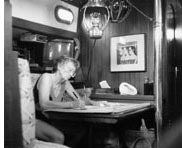 The
red tape involved in sailing to India, Don’s birthplace, finds us flying,
instead, to Calcutta. Standing aside as I watch Don recapture his childhood
haunts around Dhamtari gives meaning to the names and places he’s spoken
of. We fly through the pass in the Himalayas to touch down in Kathmandu where
we’re greeted by Ethel and Ed Metzler. A special aspect is added when we
share the knowledge of friends residing at our destination.
The
red tape involved in sailing to India, Don’s birthplace, finds us flying,
instead, to Calcutta. Standing aside as I watch Don recapture his childhood
haunts around Dhamtari gives meaning to the names and places he’s spoken
of. We fly through the pass in the Himalayas to touch down in Kathmandu where
we’re greeted by Ethel and Ed Metzler. A special aspect is added when we
share the knowledge of friends residing at our destination.
A question most asked and easily answered
is, “What is your favorite place?”
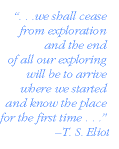 The
tiny atoll in the Chagos Archipelago, 1,000 miles south of India, becomes this
place. No one lives on these islands, just sailboats here. Food and fuel supplies
for this place takes planning in order to enjoy such unspoiled beauty for three
months before sailing on to Kenya.
The
tiny atoll in the Chagos Archipelago, 1,000 miles south of India, becomes this
place. No one lives on these islands, just sailboats here. Food and fuel supplies
for this place takes planning in order to enjoy such unspoiled beauty for three
months before sailing on to Kenya.
Meeting Dr. Mary Oyer in Nairobi again adds
a rich dimension to our visit. She helped shape many of my ideas about creativity.
Observing the birds and beasts of the jungle while on safaris offers a different
zoo experience. To continue south along the Mozambique Channel takes planning
and shared information with other captains to complete this leg successfully.
There is a strong current flooding south along the coast that can cause awesome
seas when confronted with strong winds howling from the South Pole. Just a day’s
sail from Durban we are suddenly challenged by this buster. It’s an exhausting
night. The tools of knowledge gathered help us gain a blustery entrance to Durban.
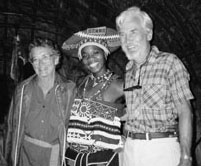 South Africa is beautiful. 1991 emerged as
a year of dialogue about apartheid. We observe the Codessa Congress as an instrument
of discourse between the black and white leaders. Sailing around the Cape of
Good Hope becomes an exercise of stamina. We are on a windless sea with our
two sources for auto-steering not functioning. This finds us, for the first
time in over five years, standing at the helm for five days and nights.
South Africa is beautiful. 1991 emerged as
a year of dialogue about apartheid. We observe the Codessa Congress as an instrument
of discourse between the black and white leaders. Sailing around the Cape of
Good Hope becomes an exercise of stamina. We are on a windless sea with our
two sources for auto-steering not functioning. This finds us, for the first
time in over five years, standing at the helm for five days and nights.
The Atlantic Ocean beckons. One more ocean
and we’re home. Misgivings that filled those beginning views gradually
faded from my journals, replaced with a new way to look at this world of ours.
This circumnavigation of five and a half years and 20,500 miles found the
two of us better friends and having gained respect for the expertise we each
brought to such a journey. Don shared medical knowledge generously, but also
became an expert diesel mechanic, plumber, electrician and fish provider. My
talents included being a good helmsperson, scraper of barnacles from the boat,
gourmet fish chef and painter of pictures.
Return to December
Bulletin contents
The journey of
the magi, and travel journaling, editorial
by Rachel Lapp
Lifelong learning: the long approach
home by President Shirley H. Showalter
On service: Ireland,
Indiana, Mali by Jacob Liechty ’02
Lessons from Africa by Sally Jo Milne ’67 with
Rachel Lapp
Pole position: uncluttering
down under by Greg Lehman ’93
Dear Diary: GC senior reflects on Dominican donation
by Alicia Montoya ’01
Return to Goshen College home page

 “And
I have felt a presence that disturbs me with joy whose dwelling is the light
of setting suns and the round ocean and the living air and the mind of man.”
“And
I have felt a presence that disturbs me with joy whose dwelling is the light
of setting suns and the round ocean and the living air and the mind of man.”


 The
red tape involved in sailing to India, Don’s birthplace, finds us flying,
instead, to Calcutta. Standing aside as I watch Don recapture his childhood
haunts around Dhamtari gives meaning to the names and places he’s spoken
of. We fly through the pass in the Himalayas to touch down in Kathmandu where
we’re greeted by Ethel and Ed Metzler. A special aspect is added when we
share the knowledge of friends residing at our destination.
The
red tape involved in sailing to India, Don’s birthplace, finds us flying,
instead, to Calcutta. Standing aside as I watch Don recapture his childhood
haunts around Dhamtari gives meaning to the names and places he’s spoken
of. We fly through the pass in the Himalayas to touch down in Kathmandu where
we’re greeted by Ethel and Ed Metzler. A special aspect is added when we
share the knowledge of friends residing at our destination.
